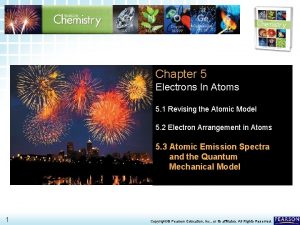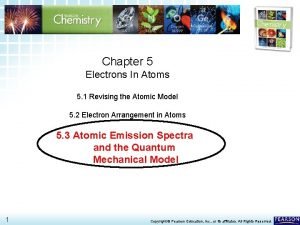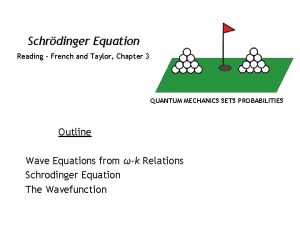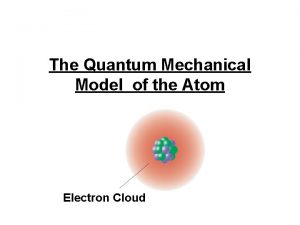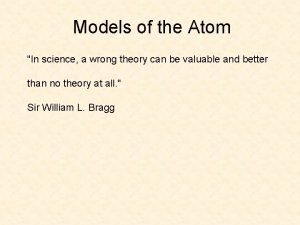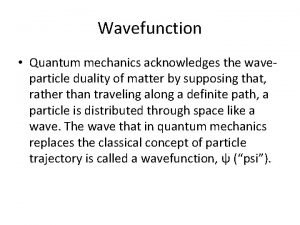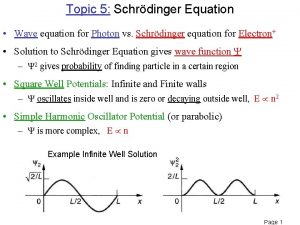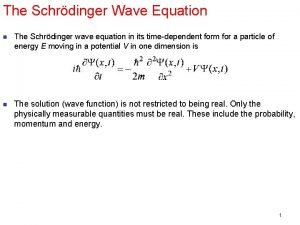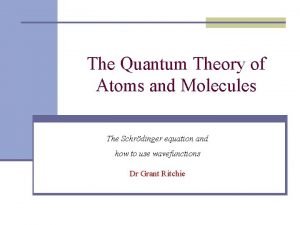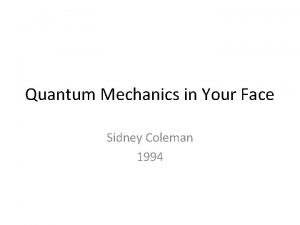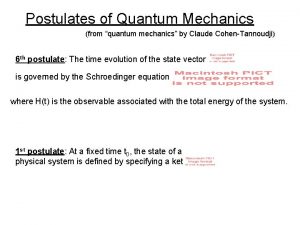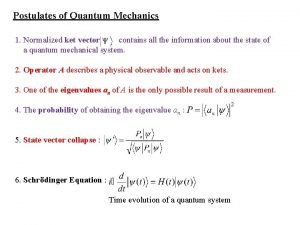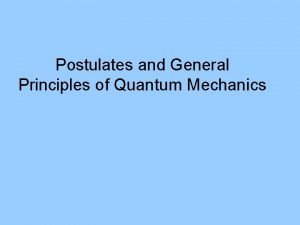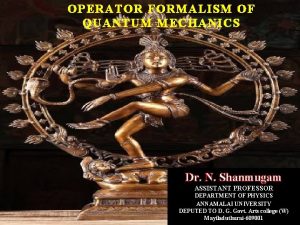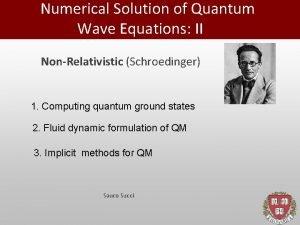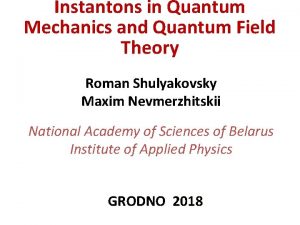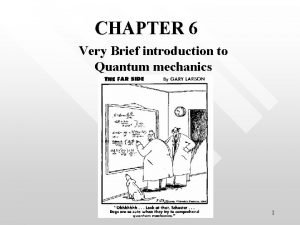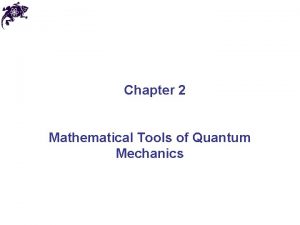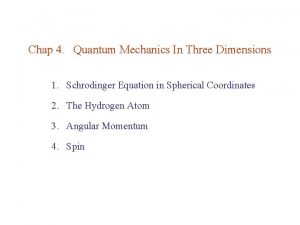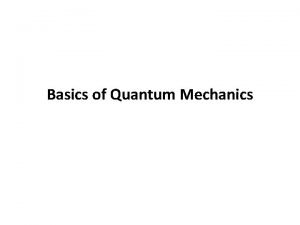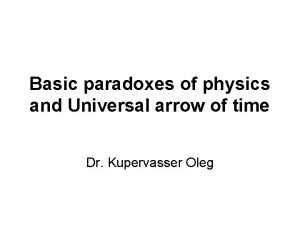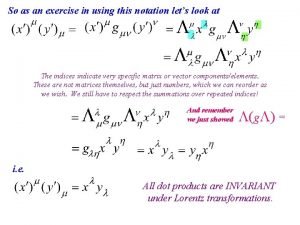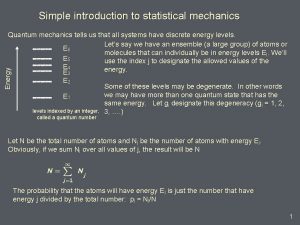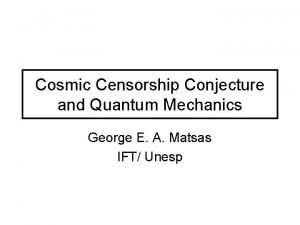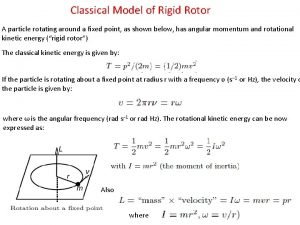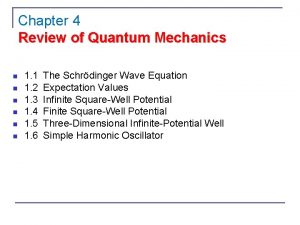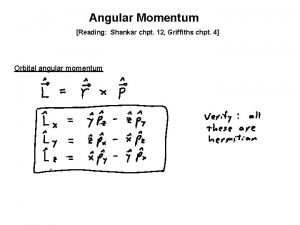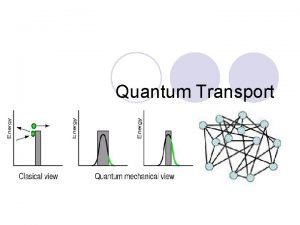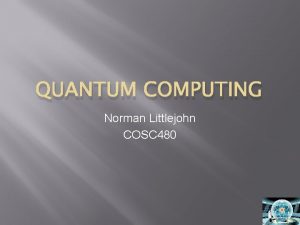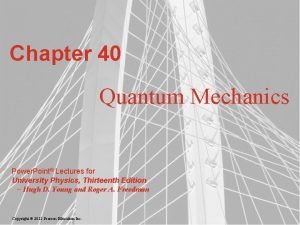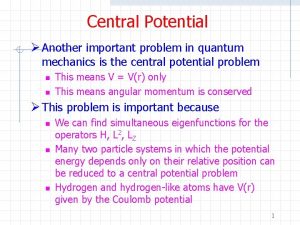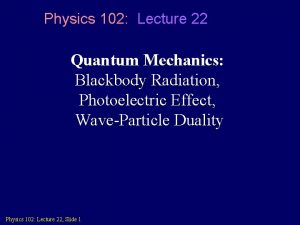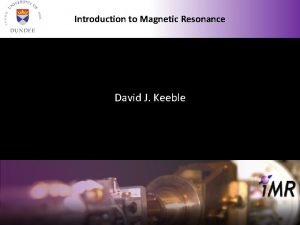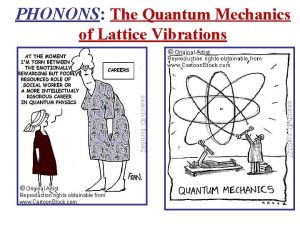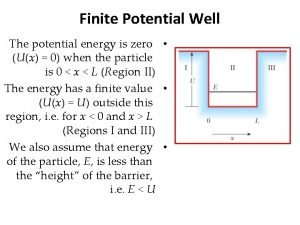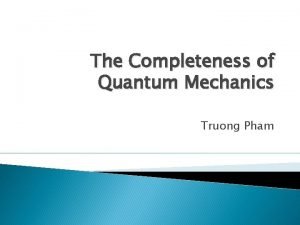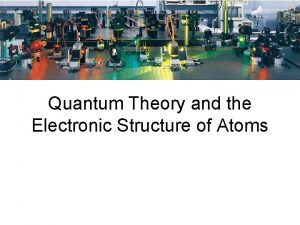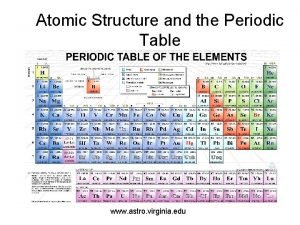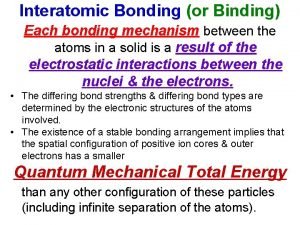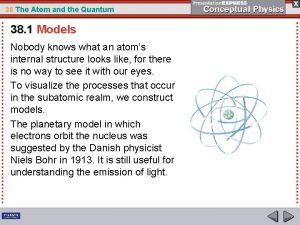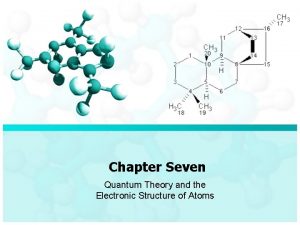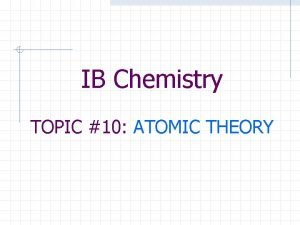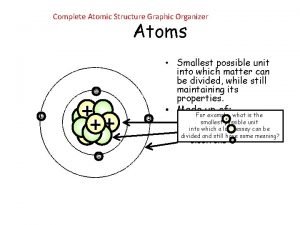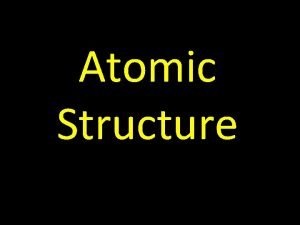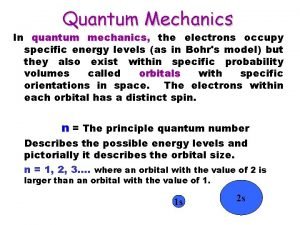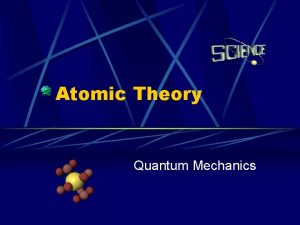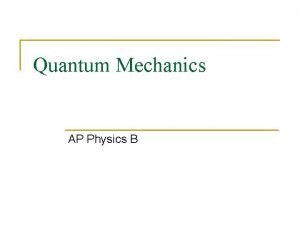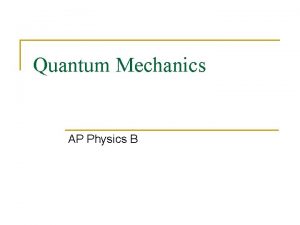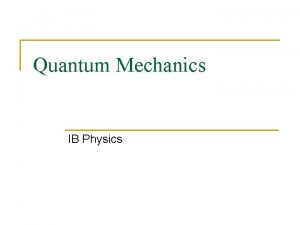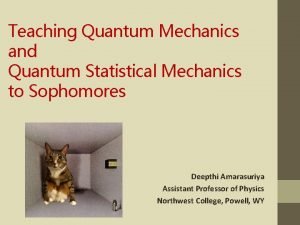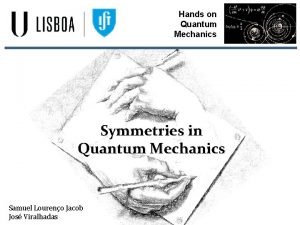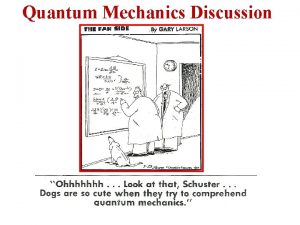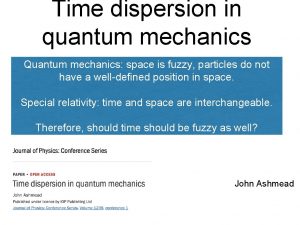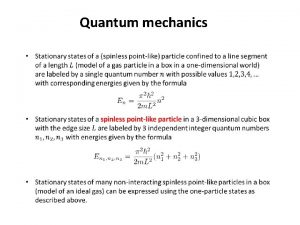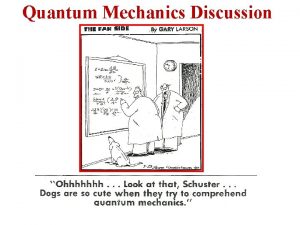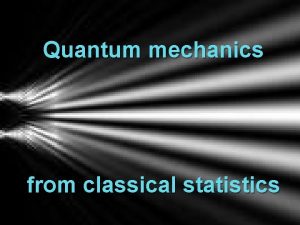5 QUANTUM MECHANICS AND ATOMIC STRUCTURE CHAPTER 5




















![Radial Distribution Functions: RDFs Prob(r) = r 2[R(r)]2 ┃Ψ┃2 x 4πr 2 dr General Radial Distribution Functions: RDFs Prob(r) = r 2[R(r)]2 ┃Ψ┃2 x 4πr 2 dr General](https://slidetodoc.com/presentation_image/31a83a34f857f6286d3340788435d938/image-21.jpg)
























![§ Be, 1 s 22 s 2 or [He]2 s 2 § B, 1 § Be, 1 s 22 s 2 or [He]2 s 2 § B, 1](https://slidetodoc.com/presentation_image/31a83a34f857f6286d3340788435d938/image-46.jpg)



![§ n = 3: Na, [He]2 s 22 p 63 s 1 or [Ne]3 § n = 3: Na, [He]2 s 22 p 63 s 1 or [Ne]3](https://slidetodoc.com/presentation_image/31a83a34f857f6286d3340788435d938/image-50.jpg)


















- Slides: 68

5 QUANTUM MECHANICS AND ATOMIC STRUCTURE CHAPTER 5. 1 The Hydrogen Atom 5. 2 Shell Model for Many-Electron Atoms 5. 3 Aufbau Principle and Electron Configurations 5. 4 Shells and the Periodic Table: Photoelectron Spectroscopy 5. 5 Periodic Properties and Electronic Structure General Chemistry I 1

Colors of Fireworks from atomic emission red from Sr orange from Ca yellow from Na green from Ba blue from Cu General Chemistry I 2

5. 1 THE HYDROGEN ATOM - The hydrogen atom is the simplest example of a one-electron atom or ion (i. e. H, He+, Li 2+, …). - For solution of the Schrödinger equation, Cartesian coordinates, x, y, z spherical coordinates, r, , to express angular orientation. General Chemistry I 3

Energy Levels Ø For a hydrogen atom, V(r) = Coulomb potential energy Ø Solutions of the Schrödinger equation 1 rydberg = 2. 18× 10 -18 J Ø Principal quantum number n indexes the individual energy levels. General Chemistry I 4

Coordinate Systems V(x, y, z) – can be expressed in various coordinate systems. Spherical polar coordinates (r, θ, Ф) vs. Cartesian coordinates (x, y, z) For Coulomb potential, V, convenient to express in SPC (V = -e 2/r); Cartesian, V = -e 2/[x 2 + y 2 +z 2]1/2 - Cartesian Coordinates - Spherical Polar Coordinates (SPC) General Chemistry I 5

Quantization of the Angular Momentum any integral value from 0 to n-1 value of l 0 1 2 3 orbital type s p d f orbitals General Chemistry I 6

For every value of n, n 2 sets of quantum numbers General Chemistry I 7

Energy level diagram for the H atom These sets of state are said to be degenerate. General Chemistry I 8

Boundary Conditions yield quantum numbers! General Chemistry I 9

Wave Functions radial part angular part: spherical harmonics General Chemistry I 10

- Spherical Polar Coordinates and the Wave Function Depends only on r Depends only on , - Schrödinger wave function → factored into radial (R) and angular (Y) functions General Chemistry I

Orbitals EXAMPLE 5. 1 General Chemistry I 12

Specification of the Wave Functions: Orbitals Ø Schrödinger’s Wave Function i. e. ) n = 3 (only one orbit in the Bohr- de Broglie model) 32 (nine) different ways the electron can vibrate to form a standing wave → 9 degenerate quantum states Ø Orbitals replacement of Bohr’s orbit for 3 D Schrödinger’s wave function - Radial part, Rnℓ(r) Laguerre polynomial (rn-1) x e-r/(na 0 ) - Angular part, Yℓm(θ, Ф) Legendre function (sin θ & cos θ) x eim. Ф * a 0 ← Bohr’s radius General Chemistry I 13

Spherical Symmetry: no angular nodes No radial node n=1 n = 2 1 radial node n = 3 2 radial nodes n = 2 No radial node 1 angular node n = 3 1 radial node 2 angular nodes n = 3 No radial node General Chemistry I 14

Sizes and Shapes of Orbitals Ø Graphical representations of the orbitals 1) Slicing up 3 D space into various 2 D and 1 D regions and examining the value of wave function at each point. General Chemistry I 15

2) Looking only at the radial behavior (“vertical slice”) R 100(r) General Chemistry I 16

General Chemistry I 17

s orbitals Ø s orbital: constant Y All s orbitals are spherically symmetric. General Chemistry I 18

- 1 s (n = 1, ℓ = 0, m = 0) R 10(r) and Y 00(θ, Ф) a function of r only * spherically symmetrical * exponentially decaying * no nodes - 2 s (n = 2, ℓ = 0, m = 0) R 20(r) and Y 00(θ, Ф) zero at r = 2 a 0 = 1. 06Å nodal sphere or radial node [r<2 ao: Ψ>0, positive] [r>2 ao: Ψ<0, negative] General Chemistry I 19

1 s 2 s 3 s isosurface A surface of points with the same value of wave functions wave function plot radial probability density (or function) plot General Chemistry I 20
![Radial Distribution Functions RDFs Probr r 2Rr2 Ψ2 x 4πr 2 dr General Radial Distribution Functions: RDFs Prob(r) = r 2[R(r)]2 ┃Ψ┃2 x 4πr 2 dr General](https://slidetodoc.com/presentation_image/31a83a34f857f6286d3340788435d938/image-21.jpg)
Radial Distribution Functions: RDFs Prob(r) = r 2[R(r)]2 ┃Ψ┃2 x 4πr 2 dr General Chemistry I 21

Boundary Surfaces - No clear boundary of an atom - Defining the size of atom as the extent of a “balloon skin” inside which 90% of the probability density of the electron is contained. 1 s: 1. 41 Å, 2 s: 4. 83 Å, 3 s: 10. 29 Å An ns orbital has n-1 radial nodes. General Chemistry I 22

p Orbitals y 2 p 0 orbital : R 21 Y 10 (n = 2, ℓ =1, m = 0) y 2 · Ф = 0 → cylindrical symmetry about the z-axis · R 21(r) → r/a 0 no radial nodes except at the origin · cos θ → angular node at θ = 90 o, x-y nodal plane · r cos θ → z-axis 2 p 0 → labeled as 2 pz General Chemistry I 23

2 p+1 and 2 p-1 orbitals: R 21 Y 11, R 21 Y 1 -1 (n = 2, ℓ = 1, m = ± 1) · Y 11(θ, Ф) → e±i. Ф = cos. Ф ± i sin. Ф ← Euler’s formula was used · taking linear combinations of these gave two real orbitals, called 2 px and 2 py - px and py differ from pz only in the angular factors (orientations). General Chemistry I 24

Wave function and RDF plots for 2 p and 3 p orbitals 2 p 3 p r 2 Rnl 2 General Chemistry I 25

General Chemistry I 26

d Orbitals Ø d-orbitals General Chemistry I 27

General Chemistry I 28

Orbital Shapes and Sizes: General Notes General Chemistry I 29

General Chemistry I 30

Stern-Gerlach Experiment: experimental evidence for the existence of electron spin Stern and Gerlach (1926): Ground state Na atoms were passed through a strong inhomogeneous magnetic field. General Chemistry I · All spin magnetisms in inner orbitals → cancelled, except an electron in 3 s orbital. · Y (θ, Ф)(3 s) → no rotation · The intrinsic magnetism of the 3 s electron → only possible to respond to the external field. · 3 s electrons → line up with their north poles either along or against the main north pole of the magnet. The lack of a “straight-through” beam with the magnet → clear evidence of 31 two-

Electron Spin Ø ms, spin magnetic quantum number - An electron has two spin states, as ↑(up) and ↓(down), or a and b. - the values of ms, only +1/2 and -1/2 General Chemistry I 32

5. 2 SHELL MODEL FOR MANY-ELECTRON ATOMS - In many-electron atoms, Coulomb potential energy equals the sum of nucleus-electron attractions and electron-electron repulsions. - No exact solutions of Schrödinger equation - In a helium atom, r 1 = the distance of electron 1 from the nucleus General Chemistry I r 2 = the distance of electron 2 from the nucleus r 12 = the distance between the two electrons 33

r 1≡ (r 1, θ 1, Ф 1) interelectron distance r 12 ≡┃r 1 – r 2┃ r 2≡ (r 2, θ 2, Ф 2) Interparticle distance in He Repulsion between electrons: This new cross-term makes the Schrodinger equation impossible to solve exactly and causes the Bohr model to fail for He and other atoms Screening of one electron by another General Chemistry I 34

Hartree Orbitals Ø Self-consistent field (SCF) orbital approximation method by Hartree, Fock, Slater, and others - all electrons were treated as independent, meaning that we neglect the repulsion term. - Building up an effective nuclear charge Zeffe i. e. ) for He, Zeff(He) = 1. 6875 < 2 General Chemistry I 35

Ø Three simplifying assumptions by Hartree The wave function becomes a product of these one-electron orbitals. 3. The effective field is spherically symmetric; that is, it has no angular dependence. The equations for the unknown effective field and the unknown one-electron orbitals must be solved by iteration until a selfconsistent solution is obtained. General Chemistry I 36

E. g. for the ground state of He, 1 s 2 occupancy 1 s orbital General Chemistry I 1 s orbital 37

The ground state of Ar, Z = 18 General Chemistry I 38

sum of the radial probability density functions of all the occupied orbitals. General Chemistry I 39

Shielding Effects - Energy-level diagrams for many-electron atoms 1) The degeneracy of the p, d, and f orbitals is removed, due to the difference of Zeff from the Coulomb field. 2) Energy values are distinctly shifted from the values of corresponding H orbitals due to the strong attraction by nuclei with Z > 1. - Each electron attracted by the nucleus, and repelled by the other electrons. → shielded from the full nuclear attraction by the other electrons. General Chemistry I 40

- effective nuclear charge, Zeff e < Ze - Hartree orbital energy (rydbergs) E. g. For Ar (Z =18), Zeff(1) ~ 16, Zeff(2) ~ 8, Zeff(3) ~ 2. 5 General Chemistry I 41

Energy level diagram for many-electron atoms General Chemistry I 42

Ø Penetration: s-electron – very close to the nucleus highly penetrates through the inner shell. p-electron – penetrates less than an s-orbital effectively shielded from the nucleus In a many-electron atom, because of the effects of penetration and shielding, the order of energies of orbitals in a given shell is s < p < d < f. Order of orbital shielding (for fixed value of n): Zeff(s) > Zeff(p) > Zeff(d) > Zeff(f) General Chemistry I 43

5. 3 AUFBAU PRINCIPLE AND ELECTRON CONFIGURATIONS The Building-up (Aufbau) Principle is a set of rules that allows us to construct ground state electron configurations of the elements. 1. 2. 3. Assume electrons ‘occupy’ orbitals in such a way as to minimize the total energy (lowest energy first). Assume a maximum of two electrons can ‘occupy’ an orbital and these must have opposite spins. (Pauli’s Exclusion Principle: no two electrons in an atom can have the same set of quantum numbers). Assume electrons occupy unoccupied degenerate subshell orbitals first, and with parallel spins (Hund’s rule). In building-up electron configurations, in order of energy, subshell energy overlap must be taken into account (see later). General Chemistry I 44

Electron configurations of first ten elements (H to Ne) ØElectron configuration of an atom is a list of all its occupied orbitals, with the numbers of electrons that each one contains. Standard notation Box and arrow notation (showing electron spins) § H, 1 s 1 § He, 1 s 2 § Li, 1 s 22 s 1 or [He]2 s 1 Valence electron Core electrons General Chemistry I 45
![Be 1 s 22 s 2 or He2 s 2 B 1 § Be, 1 s 22 s 2 or [He]2 s 2 § B, 1](https://slidetodoc.com/presentation_image/31a83a34f857f6286d3340788435d938/image-46.jpg)
§ Be, 1 s 22 s 2 or [He]2 s 2 § B, 1 s 22 p 1 or [He]2 s 22 p 1 § C, 1 s 22 p 2 or [He]2 s 22 p 2 → 1 s 22 px 12 py 1 General Chemistry I parallel spins by Hund’s rule 46

- Elements in Period 2 (from Li to Ne), the valence shell with n = 2. - p-block elements: N to Ne, filling of p orbitals s-block elements: H to Be, filling of s orbitals General Chemistry I 47

Ø Magnetic properties as a test of electronic configurations - paramagnetic: a substance attracted into a magnetic field with one or more unpaired electrons - diamagnetic: a substance pushed out of a magnetic field with all electrons paired Examples: paramagnetic: H, Li, B, C diamagnetic: He, Be C General Chemistry I 48

General Chemistry I 49
![n 3 Na He2 s 22 p 63 s 1 or Ne3 § n = 3: Na, [He]2 s 22 p 63 s 1 or [Ne]3](https://slidetodoc.com/presentation_image/31a83a34f857f6286d3340788435d938/image-50.jpg)
§ n = 3: Na, [He]2 s 22 p 63 s 1 or [Ne]3 s 1 to Ar, [Ne]3 s 23 p 6 § n = 4: from Sc (scandium, Z = 21) to Zn (zinc, Z = 30) the next 10 electrons enter the 3 d-orbitals (d-block elements) Ø The (n+l) rule Order of filling subshells in neutral atoms is determined by filling those with the lowest values of (n+l) first. Subshells in a group with the same value of (n+l) are filled in order of increasing n, due to orbital screening. order: 1 s < 2 p < 3 s < 3 p < 4 s < 3 d < 4 p < 5 s < 4 d < … § n = 5: 5 s-electrons followed by the 4 delectrons n = 6: Ce (cerium, [Xe]4 f 15 d 16 s 2) General Chemistry I 50

Alternative Pictorial Representation of Orbital Energy Order General Chemistry I 51

Anomalous Configurations Exceptions to the Aufbau principle General Chemistry I 52

Filling of electron subshells in relation to the periodic table General Chemistry I 53

All atoms in a given period have the same type of core with the same n. All atoms in a given group have analogous valence electron configurations that differ only in the value of n. Group 18/VIII Group 1/IA Period 2 Period 3 Period 4 Period 5 Period 6 Period 7 General Chemistry I 54

5. 4 SHELLS AND THE PERIODIC TABLE: PHOTOELECTRON SPECTROSCOPY Ø A shell is defined precisely as a set of orbitals that have the same principal quantum number. Ø The photoelectron spectroscopy (PES) principle determining the energy level of each orbital by measuring the ionization energy required to remove each electron from the atom General Chemistry I 55

Basic design of a PE spectrometer General Chemistry I 56

General Chemistry I 57

- Koopmans’ approximation, - with the frozen orbital approximation: the orbital energies are the same in the ion, despite the loss of an electron. E. g. for Ne with 1 s 2 2 p 6 General Chemistry I 58

General Chemistry I 59

General Chemistry I 60

(Fig. 5. 25) Energies of atomic subshells, determined by PES General Chemistry I 61

5. 5 PERIODIC PROPERTIES AND ELECTRONIC STRUCTURE Ø Atomic radius: defined as half the distance between the centers of neighboring atoms Ø Ionic radius: its share of the distance between neighboring ions in an ionic solid Ø General trends - r decreases from left to right across a period (effective nuclear charge increases) - r increases from top to bottom down a group (change in n and size of valence shell) General Chemistry I 62

- The rate of increase changes considerably. i. e. Li+, Na+, to K+ substantial change to Rb+, Cs+ small change due to filling d-orbitals Ø Lanthanide contraction filling of the 4 f orbitals (poor shielders) radii of 3 rd row D-block elements similar to those of 2 nd row General Chemistry I 63

Ø Molar volumes (cm 3 mol-1) of atoms in the solid phase = size of the atoms + geometry of the bonding General Chemistry I 64

Periodic Trends in Ionization Energies § From left to right, generally increase in IE 1 due to the increase of Zeff § From top to bottom, generally decrease in IE 1 due to the increase of n § From He to Li, a large reduction in IE 1 2 s e- further than 1 s e-, and 2 s e- sees a net +1 charge § From Be to B, slight reduction in IE 1 fifth e- in a higher energy 2 p orbital § From N to O, slight reduction in IE 1 2 e- in the same 2 p orbital leading to greater repulsion General Chemistry I 65

General Chemistry I 66

Electron Affinity - The periodic trends in EA parallel those in IE 1 with one unit lower shift e. g. F to F-, large EA because of its closed-shell configuration (k. J mol-1) General Chemistry I 67

10 Problem Sets For Chapter 5, 6, 18, 22, 28, 32, 38, 44, 46, 48, 56 General Chemistry I 68
 Quantum physics vs quantum mechanics
Quantum physics vs quantum mechanics Quantum physics vs quantum mechanics
Quantum physics vs quantum mechanics Atomic emission spectra and the quantum mechanical model
Atomic emission spectra and the quantum mechanical model Atomic emmision spectrum
Atomic emmision spectrum French and taylor quantum mechanics
French and taylor quantum mechanics Relative atomic mass of beryllium
Relative atomic mass of beryllium Atomic weight of oxygen
Atomic weight of oxygen Difference between atomic number and atomic mass
Difference between atomic number and atomic mass Quantum mechanical atom model
Quantum mechanical atom model Erwin schrödinger atomic theory
Erwin schrödinger atomic theory Hermitian operator
Hermitian operator Schrodinger wave equation
Schrodinger wave equation Incident wave equation
Incident wave equation Expectation value of energy in quantum mechanics
Expectation value of energy in quantum mechanics Quantum mechanics in your face
Quantum mechanics in your face Operators in quantum chemistry
Operators in quantum chemistry Postulates of quantum mechanics
Postulates of quantum mechanics Site:slidetodoc.com
Site:slidetodoc.com Operators in quantum mechanics
Operators in quantum mechanics Susan cartwright sheffield
Susan cartwright sheffield Operator formalism in quantum mechanics
Operator formalism in quantum mechanics Equation of continuity in quantum mechanics
Equation of continuity in quantum mechanics Beta positive decay
Beta positive decay Instantons in quantum mechanics
Instantons in quantum mechanics Expectation value in quantum mechanics
Expectation value in quantum mechanics Mathematical tools of quantum mechanics
Mathematical tools of quantum mechanics Quantum mechanics in three dimensions
Quantum mechanics in three dimensions Quantum mechanics basics
Quantum mechanics basics Schrodinger cat
Schrodinger cat Commutation relation in quantum mechanics
Commutation relation in quantum mechanics Introduction to quantum statistical mechanics
Introduction to quantum statistical mechanics Mark tame
Mark tame Commutation relation in quantum mechanics
Commutation relation in quantum mechanics Rigid rotor quantum mechanics
Rigid rotor quantum mechanics Finite potential well
Finite potential well Griffiths
Griffiths Transfer matrix quantum mechanics
Transfer matrix quantum mechanics Littlejohn quantum mechanics
Littlejohn quantum mechanics Quantum mechanics powerpoint
Quantum mechanics powerpoint Central potential quantum mechanics
Central potential quantum mechanics Quantum mechanics
Quantum mechanics Bohr magneton class 12
Bohr magneton class 12 Postulates of quantum mechanics
Postulates of quantum mechanics Operator in quantum mechanics
Operator in quantum mechanics Potential well in quantum mechanics
Potential well in quantum mechanics Copenhagen interpretation
Copenhagen interpretation Oxygen periodic trends
Oxygen periodic trends Chapter 7 atomic structure and periodicity
Chapter 7 atomic structure and periodicity Chemistry periodic trends
Chemistry periodic trends Ionic radii trends
Ionic radii trends Atomic number vs atomic radius
Atomic number vs atomic radius Chapter 4 atomic structure vocabulary
Chapter 4 atomic structure vocabulary Chapter 4 atomic structure
Chapter 4 atomic structure Quantum theory and the electronic structure of atoms
Quantum theory and the electronic structure of atoms Atomic structure and properties ap chemistry
Atomic structure and properties ap chemistry Ap chemistry atomic structure and periodicity
Ap chemistry atomic structure and periodicity Structure of the atom and the periodic table
Structure of the atom and the periodic table Ape man practice
Ape man practice Atomic structure and interatomic bonding
Atomic structure and interatomic bonding Chapter 38 the atom and the quantum
Chapter 38 the atom and the quantum Quantum structure
Quantum structure Atomic structure worksheet
Atomic structure worksheet 460 bc atomic structure
460 bc atomic structure Atomic structure of conductors
Atomic structure of conductors Ib chemistry atomic structure
Ib chemistry atomic structure Ib chemistry atomic structure
Ib chemistry atomic structure Atoms graphic organizer
Atoms graphic organizer Aristotle atomic
Aristotle atomic Z atomic symbol
Z atomic symbol


